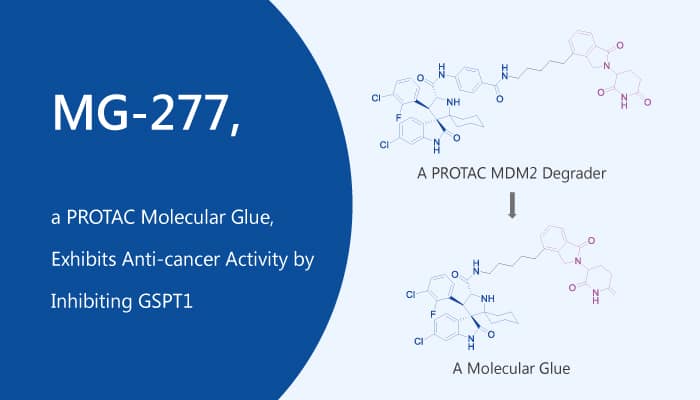Proteolysis targeting chimeras (PROTACs) induce protein degradation. A typical PROTAC small-molecule degrader consists of three essential components: a ligand that binds the protein of interest, a second ligand that binds to and recruits an E3 ligase degradation complex, and a linker tethering the two ligands together. MD-222, a bona fide MDM2 PROTAC degrader, converts it into a “molecular glue”, as exemplified by MG-277. Especially, MG-277 consists of MDM2 inhibitor MI-2103, Lenalidomide moiety, and a linker. MG-277 induces only moderate MDM2 degradation and fails to activate wild-type p53 but is highly potent in inhibition of tumor cell growth in a p53-independent manner.

MG-277 works as molecular glue, inducing degradation of the G1 to S phase transition 1 (GSPT1) protein.
In particular, MG-277 induces the degradation of GSPT1 to achieve its potent anticancer activity. Furthermore, MG-277 effectively and specifically induces the degradation of GSPT1 with a DC50 of 1.3 nM in RS4;11 cells. Surprisingly, MG-277 is very potent and effective in inhibition of cell growth in both the RS4;11/IRMI-2 and HL-60 leukemia lines, achieving IC50 values of 3.9 and 8.3 nM, respectively. Moreover, MG-277 potently inhibits cell growth in MDA-MB231 and MDA-MB-468 breast cancer cell lines through an MDM2- independent mechanism, with IC50 values of 39.4 and 26.4 nM, respectively. Besides, MG-277 displays IC50 values of 1.3, 24.6, and 7.9 nM in acute leukemia cell lines RS4;11, MOLM-13, and MV4;11, respectively,
All in all, MG-277 induces only moderate MDM2 degradation and fails to activate wild-type p53. MG-277 is highly potent in inhibition of tumor cell growth in a p53-independent manner. MG-277 is not a PROTAC MDM2 degrader but instead works as a GSPT1 degrader.